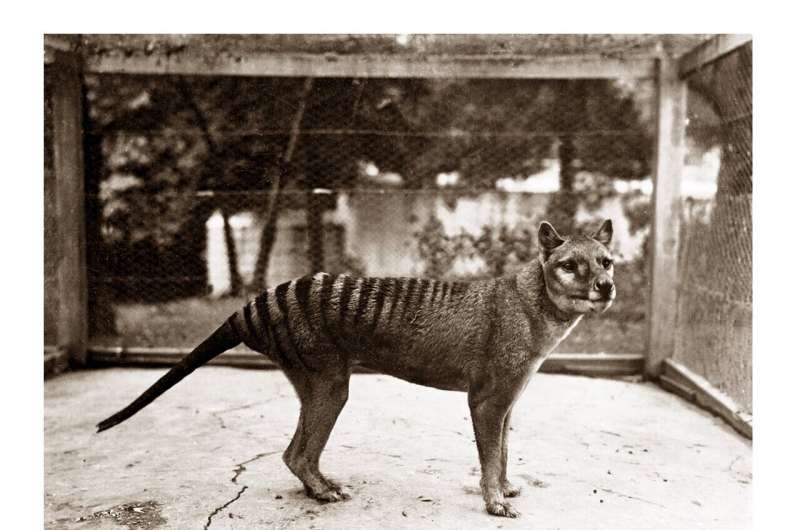March 22, 2023 report
This article has been reviewed according to Science X's editorial process and policies. Editors have highlighted the following attributes while ensuring the content's credibility:
fact-checked
peer-reviewed publication
trusted source
proofread
Researchers tentatively place Tasmanian tiger extinction in the late 1990s

An international group of researchers led by the University of Tasmania has taken a fresh look into the disappearance, and conceivable reappearance, of the Tasmanian tiger thylacine. The last thylacine confirmed killed in the wild was in 1930, and the last specimen in captivity died at a Tasmanian zoo in 1936. Since then, sightings have regularly persisted across Tasmania, though no captured creatures or images have been offered to prove its survival.
With the possibility that the creature had persisted well past its addition and eventual removal from the endangered species list with an official designation of "extinct," the researchers wanted to model the most likely last refuges of the iconic predator. In the paper, "Resolving when (and where) the Thylacine went extinct," researchers modeled 1,237 reported sightings from 1910 to the present day.
For the study, published in Science of The Total Environment, researchers pulled from every available source: records from government archives, published reports, museum collections, newspaper articles, contemporary correspondence, private collections or other miscellaneous citations and testimony. The team even poured over microfilm records to compile their sighting database.
Next, each observation was dated, geotagged, quality-rated, and categorized by type (physical specimen, expert sighting, other observations, tracks). Using this curated sighting database, researchers mapped the sighting locations over time, taking into account that "...extinction often progresses via an intermediate process of range contractions and spatially heterogenous declines, themselves driven by a variable local intensity of threats like habitat change and hunting."
The final database comprised of 1,237 entries with 99 physical records and 429 expert sightings from former trappers, bushmen, scientists or officials, with the rest coming from the general public. Two models were created, one using a statistical extinction date and the other with optimal linear estimators.
This resulted in median extinction dates of 1999 and 2008, with the most likely (overlapping) termination date by the late 1990s—a highly controversial result unless you are a Tasmanian tiger enthusiast hoping they may still be out there. However, when restricting data to physical specimens, the models indicated extinction by 1941.
The researchers suggest that while the Tasmanian tiger is unlikely to be hiding in the temperate forests of the island today, the actual extinction year is likely much more recent than previously considered. Many examples are referred to of clustered sightings with closely matching visual descriptions, the interrelationships of which would not have been apparent when reports were submitted to authorities.
Looking at the data as a whole, the annual number of reports in the six decades spanning 1940 to1999 was relatively constant but fell substantially from 2000 to the present. This suggests the possibility of a small group of thylacine beating the odds of extinction by retreating to more remote areas, vanishing just a few years before smartphone cameras could have captured conclusive evidence.
More information: Barry W. Brook et al, Resolving when (and where) the Thylacine went extinct, Science of The Total Environment (2023). DOI: 10.1016/j.scitotenv.2023.162878
Journal information: Science of the Total Environment
© 2023 Science X Network




















